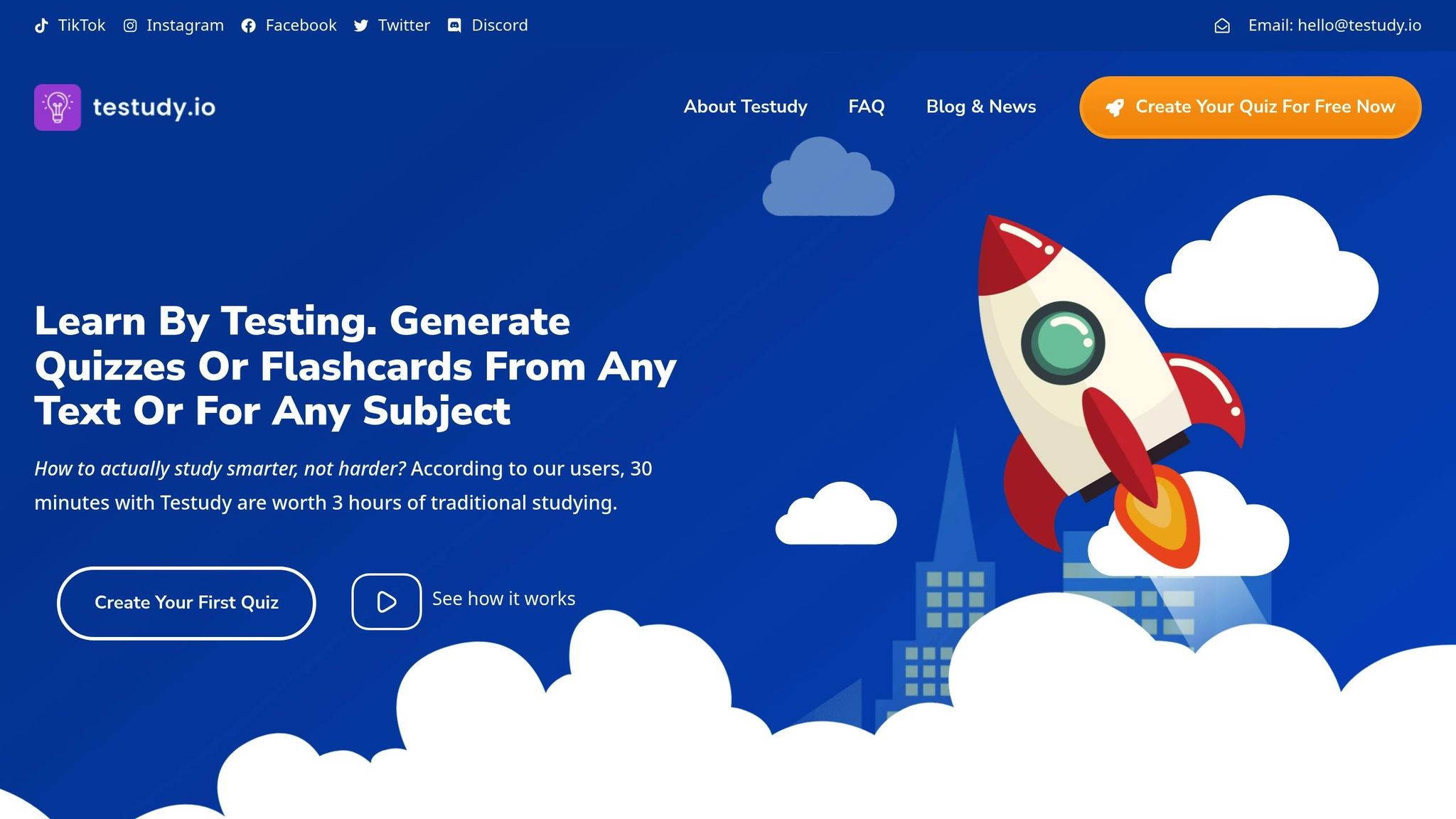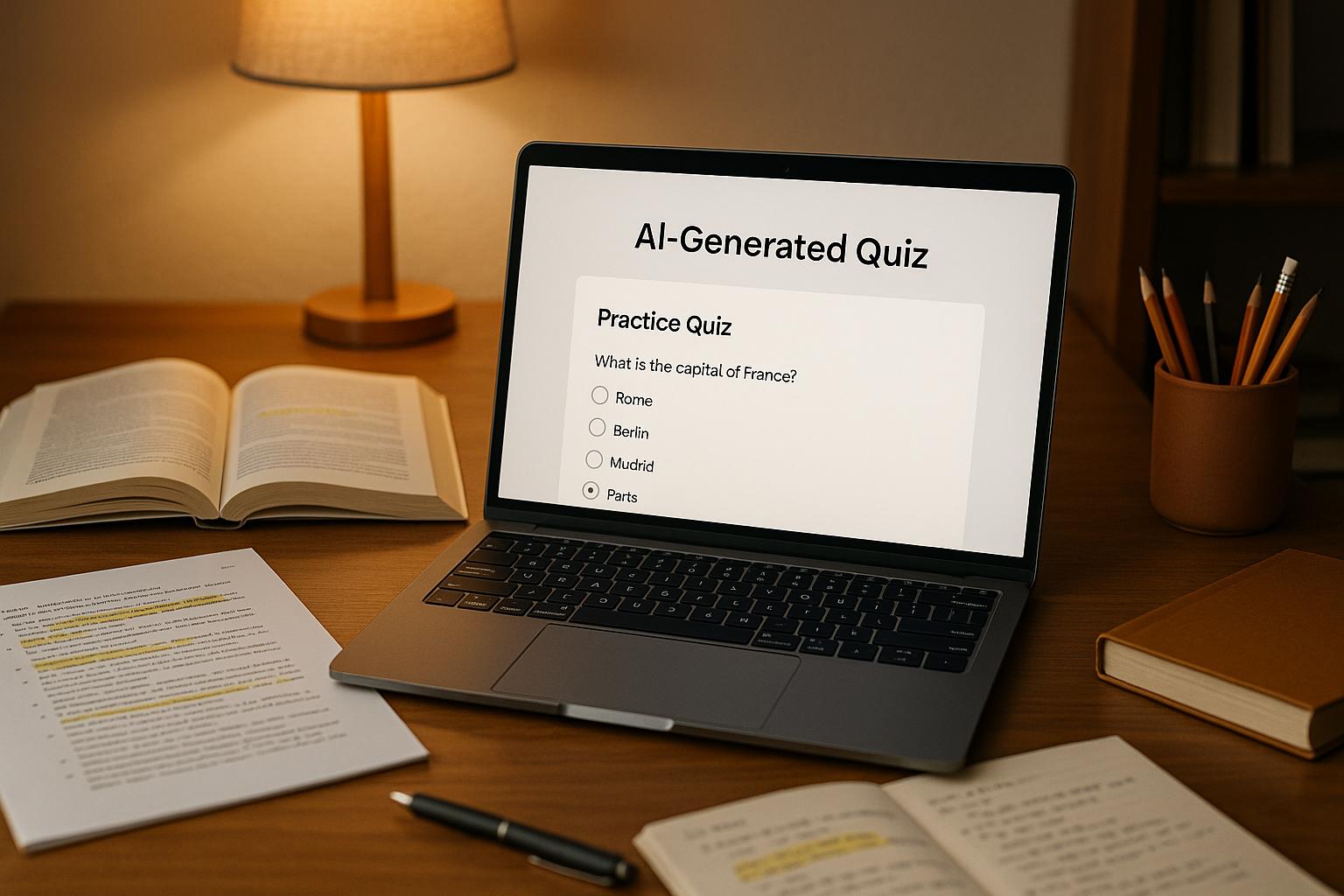AI tools now make it simple to turn study materials into quizzes in seconds. Instead of manually crafting questions, you can upload textbooks, notes, PDFs, or even videos, and the AI generates questions for you. These tools save time and help students focus on learning, not preparation.
Key Highlights:
- How It Works: Upload content (text, images, or files), and AI uses natural language processing to identify key concepts and generate questions.
- Question Formats: Includes multiple-choice, true/false, and flashcards.
- Customization: Set question difficulty, number of questions, and language.
- Benefits for Learning: Practice quizzes improve memory, highlight weak areas, and boost exam readiness.
- Platforms Like Testudy.io: Offer free and paid plans, supporting multiple languages, analytics, and collaboration features.
AI-powered quiz tools streamline studying and make it more efficient, offering students and educators a smarter way to prepare.
Step-by-Step Guide: Creating Quizzes with AI
Using AI to create quizzes turns your study materials into interactive and engaging practice tools. Here’s how you can go from start to finish.
Upload Your Text or Documents
Start by uploading your content to the AI quiz platform. Most tools make this easy with multiple upload options – you can select files directly from your device, import from services like Google Drive, or even drag and drop. Supported file types often include PDF, PowerPoint (PPT/PPTX), Word documents (DOC/DOCX), and image formats like JPG and PNG.
If you don’t have a file, you can paste text directly into the platform or describe your study material in a prompt. To get the best results, use content that highlights key points and details. You can also customize the quiz by setting preferences like the number of questions, subject focus, grade level, and language.
Once uploaded, the AI gets to work analyzing your content.
How AI Identifies Key Information
After you upload your material, the AI uses natural language processing (NLP) and machine learning to pull out essential phrases and summarize the content. This process can reduce analysis time by up to 70%.
For non-standard text formats, tools like Intelligent Document Processing (IDP) and optical character recognition (OCR) convert things like handwritten notes or unstructured data into readable, digital text. Some advanced systems even use REST APIs to extract structured data, such as tables or key-value pairs.
How AI Generates Questions and Answers
Once the AI has analyzed the material, it generates questions to test your understanding. These can include multiple-choice, single-choice, or true/false formats, complete with answer options and carefully crafted distractors to challenge your knowledge. Simply click the "Generate Quiz" button, and the system creates a fully-formed quiz in seconds.
Review and Edit Your Quiz
While AI speeds up the quiz-making process, reviewing the output is essential to ensure accuracy and alignment with your goals. Carefully check each question for clarity, correctness, and difficulty level. If needed, edit the wording to make it more balanced or unbiased.
"Always check AI-generated content before sharing with students. Verify answers and adjust difficulty as needed." – Nikki Muncey, SchoolAI
You can also tweak questions that feel too easy or hard, and add your own to fill in any gaps. By blending AI’s efficiency with your expertise, you can create a quiz that perfectly suits your educational needs.
Key Features of AI Quiz Tools
Modern AI quiz tools are reshaping how students and educators approach studying. These tools bring a range of customization options and collaborative features that cater to different learning preferences and goals.
Multiple Languages and Flexible Formats
AI quiz platforms make learning more accessible by supporting multiple languages. For instance, Testudy.io allows users to create quizzes in over 20 languages, making it easier for students to study in their native tongue or practice a foreign language they’re learning.
The flexibility doesn’t stop at language. These tools go beyond standard multiple-choice questions, offering a variety of formats such as single-choice, true/false, and flashcards. This versatility lets users switch between formats depending on their study needs, whether they’re reviewing concepts or testing detailed knowledge.
Customization and Adjustable Difficulty
One of the standout features of these tools is their ability to adapt to individual needs. Users can decide how many questions they want in a quiz, with options ranging from a few to a larger set. Some platforms even let you specify an exact number of questions for precision.
Difficulty settings further enhance the experience. Beginners can start with straightforward recall questions, while more advanced learners can tackle complex, reasoning-based challenges. A few tools also focus on identifying and addressing specific knowledge gaps, creating quizzes that target areas where improvement is needed.
Collaboration and Group Study Tools
Beyond personalization, these platforms excel in fostering collaboration. Many allow users to share quizzes through email, direct links, or website embeds, making it easy to distribute content.
Real-time collaboration features take group study to the next level. Participants can edit quizzes together and track group performance. Detailed analytics reveal how everyone is doing, pinpointing shared problem areas that need attention. Some tools even integrate with platforms like Microsoft Teams, streamlining group study sessions into existing workflows.
For added convenience, quizzes can be exported in formats like PDF, DOCX, CSV, and QTI. This ensures compatibility with various learning management systems, making it simple to incorporate AI-generated quizzes into different educational setups.
sbb-itb-3165b23
Platform Spotlight: Testudy.io

What Testudy.io Offers
Testudy.io is a platform that uses AI to transform text into quizzes and flashcards, making studying more interactive and efficient. Whether you’re working with plain text, PDFs, or lecture notes, the platform can generate single and multiple-choice quizzes and flashcards from your material. Plus, with its Chrome extension, you can instantly turn web content into quizzes.
The AI behind Testudy.io dives into your content, identifying important concepts and connections. It then creates relevant questions and answers that focus on the key material. It doesn’t stop there – Testudy.io tailors its difficulty based on how you perform, honing in on areas where you need extra help. And with support for over 20 languages, it’s a versatile tool for learners worldwide.
According to Testudy.io, 30 minutes of studying with its AI-generated resources is equivalent to about 3 hours of traditional study time. That’s a game-changer for students looking to make the most of their time.
"When I heard about the Testudy learning method, I was intrigued. The tool totally delivered – it’s awesome to have an unlimited number of tests at my disposal for any course." – Daniel Scott, Marketing student
Collaboration is another standout feature. You can share your quizzes and flashcards with study groups, classmates, or even students, making Testudy.io a valuable resource for both individual learners and educators.
Next, let’s break down the pricing options, which cater to both casual users and those with more intensive study needs.
Free vs. Pro Plan Comparison
Testudy.io’s pricing is designed to fit a variety of budgets and study habits. Whether you’re just dipping your toes in or need full access, there’s a plan for you.
| Feature | Free Plan | Pro Plans |
|---|---|---|
| Price | Free | from about $10/month |
| Access Duration | Lifetime | Monthly subscription |
| Quizzes & Flashcard Sets | Up to 3 | Unlimited |
| AI Generations | Up to 25 questions | Unlimited |
| Multi-language Support | 20+ languages | 20+ languages |
| Chrome Extension | Yes | Yes |
| Sharing Capabilities | Yes | Yes |
| Performance Analytics | Basic | Advanced |
| Priority Support | No | Yes |
The Free Plan is perfect for light use or trying out the platform. It gives you lifetime access, allowing you to create up to 3 quizzes or flashcard sets and generate up to 25 AI-powered questions. It’s a great option for students who need minimal quiz creation or want to explore the tool without any commitment.
The Pro Plan, on the other hand, is built for heavy users. With unlimited quiz and flashcard creation, as well as unlimited AI-generated questions, it’s ideal for students managing demanding study loads, educators preparing for multiple classes, or anyone who wants AI-generated quizzes as a regular part of their learning.
What makes Testudy.io especially appealing is its no-pressure pricing model. The free plan never expires, so you can use it indefinitely without feeling pushed to upgrade. If you do choose the Pro Plan, you’ll unlock all advanced features instantly, with no usage restrictions.
The platform boasts a 97% student satisfaction rate and 90% positive reviews, highlighting its value for both free and paid users.
"If Testudy existed when I started my degree, my GPA would be a lot higher. Couldn’t you make it earlier? Honestly, it saves my grades." – Sophie Moore, Law student
Best Practices for AI-Generated Quizzes
When it comes to creating effective AI-generated quizzes, a little preparation goes a long way. From selecting the right materials to refining questions and scheduling reviews, these steps can help you make the most of this technology.
Pick High-Quality Source Material
Start with solid study materials to ensure your AI-generated quizzes are as effective as possible. These tools rely on the quality of the input – whether it’s text, documents, or multimedia – to create meaningful questions. Choosing well-organized and relevant sources that align with your subject or curriculum is key to getting accurate results. For example, uploading a clearly structured chapter from a textbook can help the AI identify and generate questions that reflect key concepts and relationships.
Remember, the better the material, the better the questions. A research paper with clear headings and logical flow will produce more coherent quiz questions than a scattered collection of notes. While AI excels at processing factual content, it may struggle with abstract or highly theoretical material. In such cases, it’s a good idea to manually review and tweak the questions to ensure they meet your needs. Comprehensive and well-structured input leads to quizzes that truly test understanding.
Edit and Refine Questions
AI-generated questions are a great starting point, but they’re not always perfect. Before using them, review each question for accuracy and relevance. Make sure the questions align with your learning goals and adjust them as needed. During this process, watch out for and remove any biases that might have slipped through. As researchers Ethan Mollick and Lilach Mollick advise, "Always verify the accuracy of the examples and make sure to eliminate any harmful biases".
Use performance analytics from your platform to guide your edits. If you notice recurring mistakes in a particular topic, add more focused questions to address those gaps. This targeted approach not only improves your quizzes but also ensures you’re reinforcing the areas where you need the most practice.
Incorporate Quizzes Into Your Study Routine
Once your questions are polished, the next step is to integrate them into a consistent study plan. Randomly using quizzes won’t be as effective as a structured approach. AI tools can help you organize a study schedule, set reminders, and track your progress, ensuring all topics are systematically covered. Use key dates, like exams, along with AI-generated insights to create a focused daily plan.
Take advantage of spaced repetition features to schedule reviews at intervals that optimize memory retention. This method is far more effective than cramming all at once. Regularly update your study dashboard to track completed tasks and identify areas that need more attention. If you notice weak spots, allocate extra time to those subjects and reinforce them with additional AI-generated questions.
Flexibility is essential in any study plan. Be ready to adjust your schedule when analytics reveal unexpected gaps or when certain topics require more focus. Breaking your material into smaller, manageable chunks and alternating between topics can keep you from feeling overwhelmed. Short, focused study sessions followed by breaks can also improve retention and prevent burnout.
Conclusion: AI as a Study Partner
AI is changing the way students approach learning by reshaping how practice materials are created and used. With these tools, studying becomes more efficient, helping students achieve better results – something universities and businesses around the world are starting to rely on.
No matter the subject – biology, history, or even preparation for professional certifications – AI tailors the learning experience. It pulls out key concepts from your study materials and generates a variety of question types to test your understanding from different perspectives. Plus, it adjusts the difficulty based on how you’re progressing, making your study sessions more effective.
Platforms like Testudy.io take this a step further. With AI-powered features, they allow you to study smarter, not harder. Whether you stick with the free plan, which includes up to 3 quizzes, or go Pro for $10/month to unlock unlimited quizzes, the platform adapts to your needs. It even supports collaborative learning with options for quiz sharing and group study.
The real key to success is treating AI as a partner in your studies. By reviewing and refining the questions it generates and incorporating them into your study routine, you can combine AI’s efficiency with your own critical thinking. Together, this creates a dynamic and powerful learning approach.
FAQs
How does AI create accurate and relevant quiz questions from study materials?
AI creates precise and relevant quiz questions by leveraging natural language processing (NLP) and pre-trained models. These technologies enable the AI to grasp the meaning, structure, and main ideas of the study material, ensuring the questions it generates are closely tied to the content.
To uphold quality, AI systems often rely on structured prompts and cross-check the questions against standards specific to the subject area. While this process is efficient, occasional mistakes can slip through, making human review an important step to guarantee accuracy and relevance.
How can I adjust the difficulty and format of AI-generated quizzes to suit my study goals?
When creating AI-generated quizzes, many platforms let you adjust the difficulty level to suit your needs. Whether you’re a beginner, at an intermediate level, or ready for advanced challenges, you can align the quiz content with your knowledge and learning goals.
Most AI tools also offer flexibility in formatting. You can pick from various question types, like multiple-choice, true/false, or open-ended questions. Additionally, you can decide how many questions to include, focus on specific topics, or tweak the style to fit your preferences. These options make it simple to design quizzes that cater to your study requirements.
How can I use AI-generated quizzes to improve my study routine and retain information more effectively?
To get the best results from AI-generated quizzes, begin by using tools like Testudy.io to create personalized quizzes and flashcards based on your study materials. These quizzes are a great way to strengthen your understanding through active recall while highlighting areas that need extra attention.
Make quizzes a regular part of your study routine – daily or weekly – especially for topics that you find tough. This consistent practice doesn’t just improve memory retention; it also makes studying more interactive and productive. By customizing quizzes to match your learning needs, you can approach your studies more effectively and see better outcomes.




